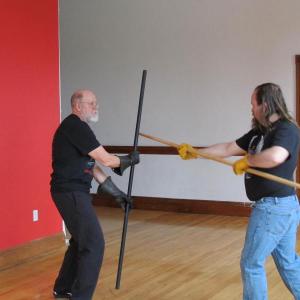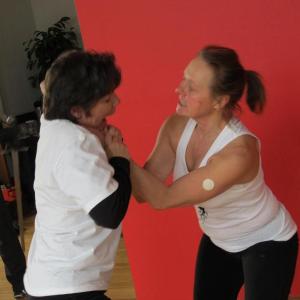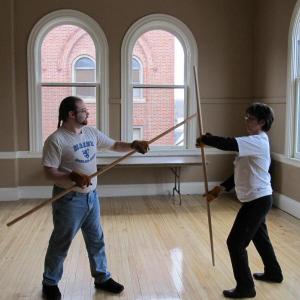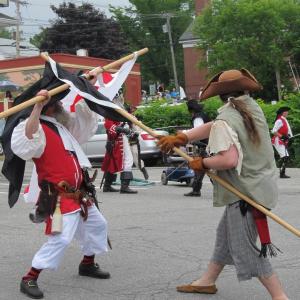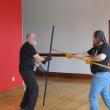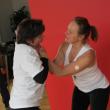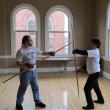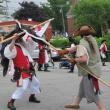Ho! Ha Guard! Turn! Parry! Dodge! Spin! Fwannnnng!
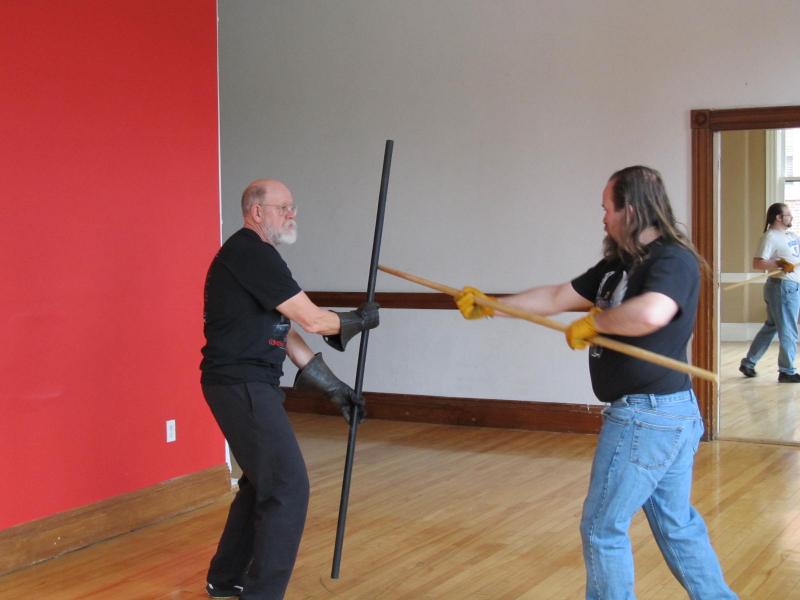 Tomm Tomlinson (l) and Chris Switzer (r) are fighting with broad swords, a heavier weapon.
Tomm Tomlinson (l) and Chris Switzer (r) are fighting with broad swords, a heavier weapon.
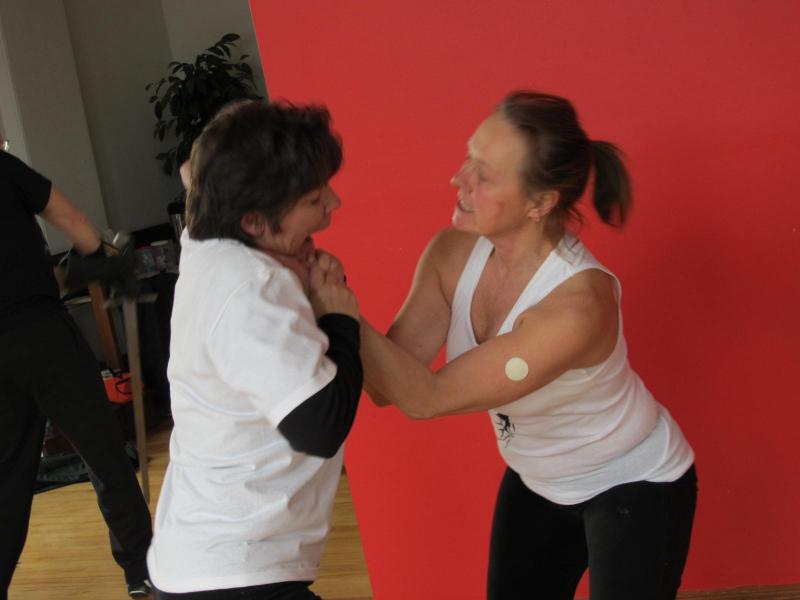 Choking (Sandi Bilbo, left, Barbara Tomlinson, right)
Choking (Sandi Bilbo, left, Barbara Tomlinson, right)
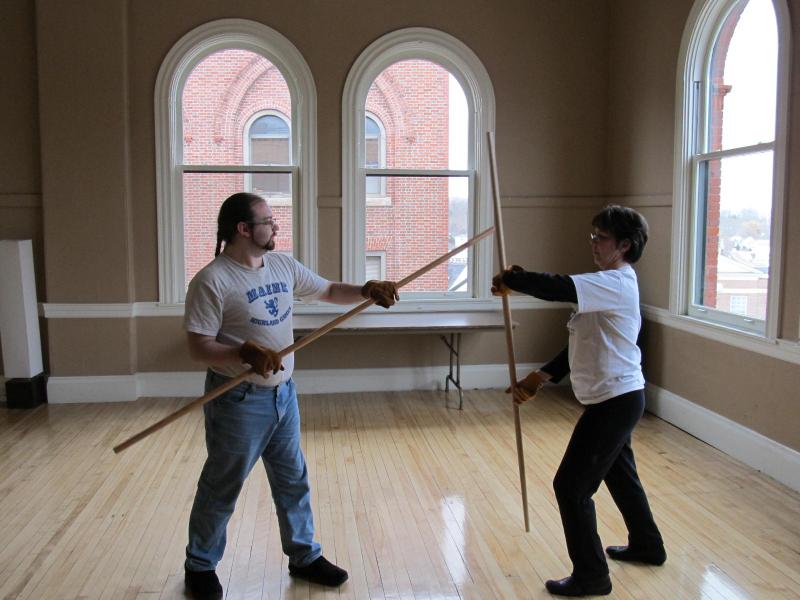 Staff fighting (Jay Inglis left, Sandi Bilbo, right)
Staff fighting (Jay Inglis left, Sandi Bilbo, right)
 The Pirates using their theatrical fighting skills during Damaraiscotta's Pirate Days weekend this summer.
The Pirates using their theatrical fighting skills during Damaraiscotta's Pirate Days weekend this summer.
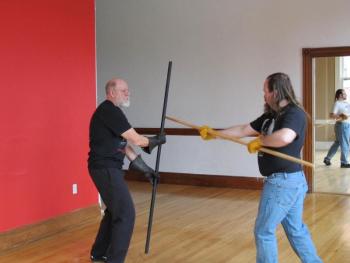 Tomm Tomlinson (l) and Chris Switzer (r) are fighting with broad swords, a heavier weapon.
Tomm Tomlinson (l) and Chris Switzer (r) are fighting with broad swords, a heavier weapon.
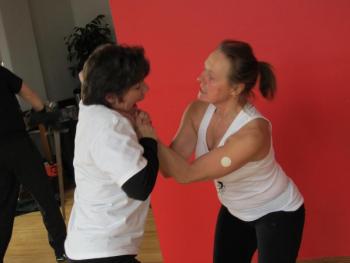 Choking (Sandi Bilbo, left, Barbara Tomlinson, right)
Choking (Sandi Bilbo, left, Barbara Tomlinson, right)
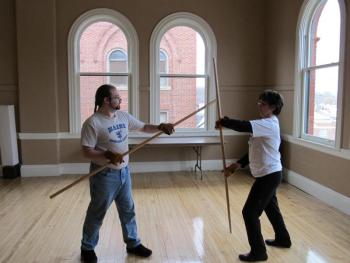 Staff fighting (Jay Inglis left, Sandi Bilbo, right)
Staff fighting (Jay Inglis left, Sandi Bilbo, right)
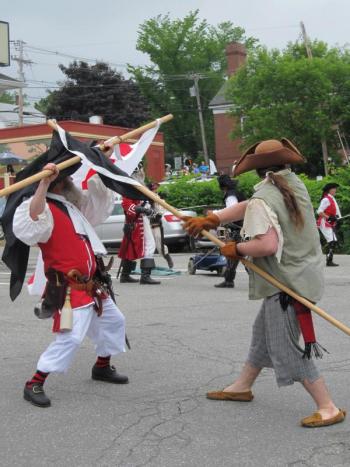 The Pirates using their theatrical fighting skills during Damaraiscotta's Pirate Days weekend this summer.
The Pirates using their theatrical fighting skills during Damaraiscotta's Pirate Days weekend this summer.
A regular day in the life of Angela Bonacasa finds her surrounded by people punching, slapping, kicking and generally commencing beatdowns with quarterstaves.
Done correctly, however, no one actually gets hurt. That’s the beauty of stage combat. Bonacasa is a certified teacher of stage combat with the Society of American Fight Directors and theatrical violence is a highly structured discipline of fight choreography among onstage characters. She offers classes in onstage fighting from classical swordplay to contemporary unarmed combat.
Bonacasa found her calling in 1993 when a roommate at New York’s American Musical and Dramatic Academy asked her to come to a stage combat class.
“Before that first 90 minutes was over, I knew this was something I wanted to do,” she said. “I didn’t know what I was going to do with it, but I knew I had to do this kind of work.”
After graduating from AMDA, she went on to receive her BFA in performance from Roosevelt University.
After building a successful career in Chicago as a fight director and stage combat instructor, Bonacasa moved to Maine in 2007. Based in Castine, she has fashioned a freelance career out of her myriad interests.
“In classic Maine fashion, you’re doing as many things as possible,” she admitted. “So, I’m an actress, a director, a fight choreographer. I teach classes and travel around the country to do short weekend intensive workshops on theatrical violence. I’ve also gotten back into working with horses, so I’m a full time into a dressage program as a student and parttime teacher.”
Most recently she has been hired as the Executive Director of the Center Theatre in Dover Foxcroft, where she’s hoping to get some stage combat classes going in the future.
Many of the repeat customers of her workshops happen to be The Pirates of The Dark Rose, in Rockport. This is the same troupe that performs during Damariscotta Pirate Days and the Camden Windjammer Festival, sailing in on their pirate ship Must Roos, invading harbors, gallivanting around, causing a ruckus, and entertaining audiences everywhere. She often works with the Pirates to expand on their theatrical skills for their performances.
Just as there are multiple disciplines within martial arts, there are so many different stage combat disciplines that must be mastered within Society of American Fight Directors. Traditional weaponry might include the single sword, daggers, rapiers, maces, knives, spears, poles and swords. Or contemporary weaponry might involve brass knuckles and knives. Unarmed combat might include choking, punching, slapping, grappling — and remember it all must look real without causing injury!
“That’s a whole challenge in itself,” Bonacasa said, “to present two actors on stage who are trained enough to look as though they’re not trained to fight at all.”
On that note: Bonacasa strongly advises those who view these pictures not to try these techniques without the proper training at the risk of injury. To find out more about Bonacasa’s work visit: Summer Stage Combat
Here is a look at how theatrical fighting works:
Broad swords: Tomm Tomlinson and Chris Switzer fight with broad swords, a heavier weapon. Because the smaller weapons are so light, it’s harder to do footwork, because you aren’t told by your body immediately what you’re doing that’s incorrect. Because of the weight of the heavier weapons, you get immediate information about what you’re doing. If you’re not ergonomically correct, your body will let you know, and you can take that information back to the lighter weapons. The broad sword you don’t see so much in contemporary plays, although there are some in adaptations of classics; mostly you’ll see that and the rapier in Romeo and Juliet and that kind of thing.
Choking: Sandi Bilbo and Barbara Tomlinson demonstrate a choking technique. Basically here what you see is all sleight of hand. As far as the audience is seeing right now, Barbara, doing the choking, looks as though she’s got her hands wrapped around Sandi’s throat when in actuality, she’s crossed her thumbs over, creating a place for Sandi to tuck her head, preventing Barbara's hands from accidentally slipping up and injuring her. There is partnering and sharing of weight going on. You’d see this technique across the board, whether in a Shakespeare play or in a contemporary piece. Choking is much more of an intimate, personal way of establishing drama between two characters than a sword or a gun. It says a lot about a character, who is willing to wrap her hands around another character’s throat and watch as she chokes the life out of her.
Staff fighting: Jay Inglis and Sandi Bilbo demonstrate staff fighting. Here, they’re sparring with quarterstaves. A quarterstaff is generally a piece of hardwood about 6-9 feet long. Because these guys are pirates, you’ll see them working with cannons in some of their performances. There are all of these long sticks used to clean the cannons and we wanted to incorporate the use of them as stage weapons. Most commonly quarterstaff work is seen with the whole Robin Hood concept. But even in contemporary movies, you’ll see Wushu, the Chinese Art of War that both Jackie Chan and Jet Li have studied. Jet Li does more of the competitive style and Jackie Chan's performance-based style, is Bejing Opera, which is where he trained.
*Robin Hood Daffy Duck, 1958
Address
Rockport, ME
United States

